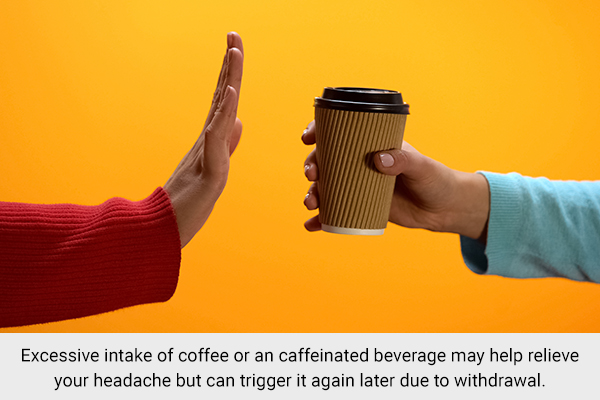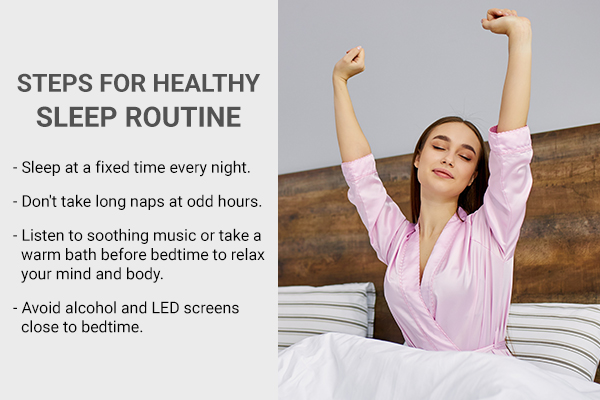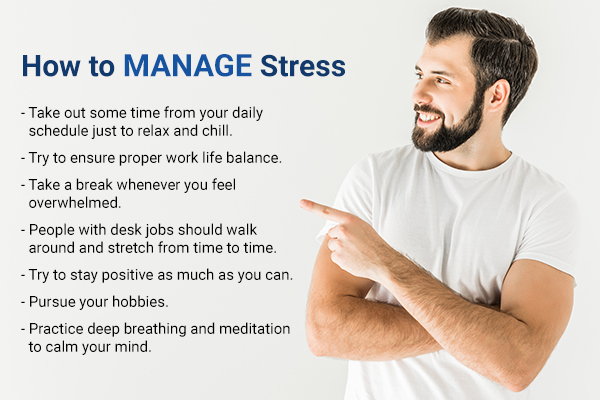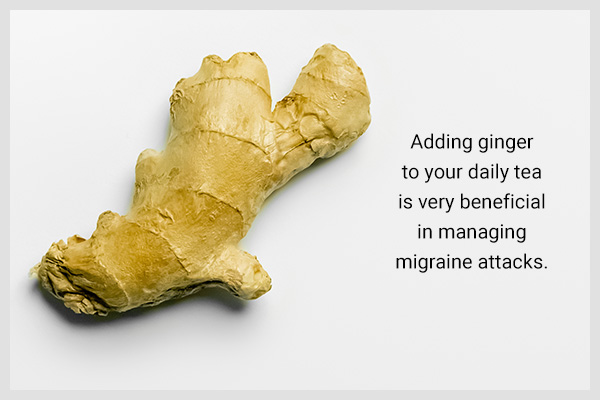In this article:
Don’t mistake a migraine for just a regular headache since migraine is much more than that. It is a painful condition of neurological roots that causes various symptoms. It is harder to make a migraine headache go away in comparison to a normal one and thus is much harder to manage. (1)(2)

Prevention of migraine is far better than keeping a migraine attack under control. The good news is that there are a lot of things you can do to ease up your migraine pain. There are medicines available to treat migraine, but implementing the necessary lifestyle changes and behavioral interventions is equally important in migraine management. (3)
Data from 2018 revealed that women were almost twice as likely as men to suffer from serious headaches or migraine in the last 3 months (i.e., 20.1% versus 10.6%), both overall and within an age group.
The percentage of people struggling with severe headaches or migraine reduced with age for both men and women, from 25.5% in those aged 18–44 years to 7.6% in those aged ≥75 years for women and from 12.3% in those aged 18–44 years to 4.0% in those aged ≥75 years for men.
Migraine is the most common reason for recurrent moderate to severe headaches; 1-year prevalence is 18% for women and 6% for men in the United States. (4)
Tips for Dealing With Migraine Headaches
It is important to know how to manage the pain and take care of yourself when a migraine strikes. Here are some of the measures you can take to deal with migraine headaches.
1. Stay in a calm environment
Migraine can cause sensitivity to light and noise. Staying away from all these will help treat and manage migraine pain.
To feel better after a migraine attack or to prevent one, lie down and focus on your breathing. Make sure the room is dark and quiet. So, turn off all the lights, relax, and try to fall asleep.
You can also try taking a warm shower to relax further. (5)
2. Avoid drinking too much coffee

Many people find drinking a cup of coffee stress relieving. This effect is due to its active component called caffeine, which is also present in tea. This is also why people often drink tea when experiencing headaches.
Unfortunately, those who have made coffee drinking a habit usually experience uneasiness and headaches all day (6) when they miss their daily dose of caffeine.
If you drink too much coffee to get relief from migraine, you may become dependent on it, and this will only lead to more headaches due to withdrawal. So, moderation is important for continued relief.
In the early stages, caffeine by itself is enough to alleviate the pain, which is why many painkillers also have caffeine as an active ingredient.
The only thing to pay attention to is not to go overboard. Don’t drink too much coffee or any caffeinated beverage for that matter as it may soothe your headache but also set you up for another due to withdrawal. (7)
3. Use a cold compress
The use of an ice or a hot pack to treat pain is generally termed temperature therapy, and migraine headaches can benefit from this too. (8)
A cold compress has been a known therapy for migraine for a long time, and there are studies that show its benefits.
Cold therapy helps in the constriction of blood vessels, which calms down migraine pain. Cold therapy also slows down the transmission of pain through the nerves and significantly lowers the intensity of migraine pain. (9)
Although its mechanism of action has not yet been confirmed, it does provide relief to your head by giving a numbing and soothing effect.
4. Get a good night’s sleep
Having a bad headache keeps one from falling asleep. Migraines may keep you up at night or interrupt your sleep. (10) So, it is important to ensure a healthy sleep routine.
You can do so by following these steps: (11)

- Sleep at a fixed time every night to establish a routine.
- Do not nap for long durations as this may give you a hard time falling asleep at night.
- Listen to relaxing music or take a warm bath to promote good sleep.
- Avoid alcohol, intense physical activity, and big heavy meals as they disrupt sleep.
- Do not watch TV or spend time scrolling down your phone to minimize any distractions that may keep you from falling asleep.
- Ask others at home to keep down the noise as it may trigger a migraine attack.
- Try to avoid drinking coffee right before bed.
- Many people often feel better by wearing sunglasses and using an umbrella in harsh sunlight.
5. Get on a healthy diet
What you eat has an impact on the condition of your migraine. So, it is important to eat wisely and follow these points: (12)(13)
- Follow a routine and eat at the same time every day. From breakfast to lunch, eat at a fixed time.
- Do not skip any meal.
- Keep a track of what you eat and what triggers a migraine attack.
6. Make sure you exercise regularly
Daily physical activity causes a secretion of chemicals in your body that block pain-signaling pathways. Exercise also helps you relax by relieving anxiety, which is known to increase migraine attacks. (14)
7. Maintain a healthy weight
There have been studies that show being overweight or obese increases the risk of migraines. So, it is important to maintain a healthy weight to avoid any symptoms of migraines. (15)
8. Try to stay stress-free

It is common knowledge that stress can trigger migraine headaches. However, stress is a part of life and cannot be escaped.
So, it is important to learn how to manage stress. Here’s what you can do: (16)
- Don’t overburden yourself with chores and work. Keep some time to relax and chill.
- Try to ensure a work-life balance.
- Take a break whenever you feel you’re too tired.
- Avoid a sedentary lifestyle. If you have a desk job, walk around and stretch every few minutes.
- Try to stay positive. A good attitude is important for your wellness.
- Pursue your hobby or do what makes you happy at least for a few minutes every day.
- Focused and deep breathing also helps in relieving stress.
9. Get a massage
A good massage can help you relax. People also go for routine massages as a part of their self-care regimen.
Massage can help prevent headaches through its soothing effects. (17) A good massage can even provide almost immediate relief from a migraine attack.
Not only a head massage but also a foot and hand massage is also a great way to relax and alleviate headaches. (18)
10. Maintain proper hydration
A dehydrated person is more likely to experience headaches or migraines.
Research shows that proper hydration can be linked to the reduction and prevention of headaches and migraine pain. People who drink adequate water every day are known to have headaches that are less severe, less frequent, and resolve easily. (19)
How to Deal With Migraine in Pregnancy?

In pregnancy, migraine should be managed using nondrug treatment options, which include:
- Relaxation
- Sleep
- Massage
- Ice packs
In these measures are not enough, treatment of acute migraine attacks can be done by using 1,000 mg of paracetamol, also known as acetaminophen, possibly as a suppository. This is deemed to be the first choice of treatment.
The risks linked with the use of aspirin and ibuprofen are evaluated to be minor when they are used only occasionally and also if they are not used during the last trimester of the pregnancy.
Triptans (such as sumatriptan, zolmitriptan, and naratriptan) and dihydroergotamine or ergotamine tartrate, however, are contraindicated in pregnancy and hence should be avoided.
Prochlorperazine for the management of nausea is improbable to be dangerous during pregnancy. Metoclopramide is permissible for use in the second and third trimesters of pregnancy. (20)
When to See a Doctor
Intense headaches are usually a common part of a migraine attack and don’t require medical attention. However, if they start to interfere with your daily chores, you might want to talk to a doctor.
Other signs that point to a need for immediate medical help include: (21)
- Vomiting
- Lightheadedness
- Seizure
- High blood pressure
- Loss of balance
- Frequent migraines (more than 5 days a month)
- Headaches with a high temperature, stiff neck, mental confusion, seizures, double vision, or a rash, to evaluate for stroke or meningitis
Most-Asked Questions About Migraine
What are some warning signs of migraine?
Before having a headache, a migraine may pose some signs that can be identified and managed to prevent a migraine attack. (22) Some of these warning signs are:
- Light sensitivity
- Irritability
- Anxiety
- Fatigue
- Continued yawning
- Food craving
Is it true that ginger helps with migraine?

Recent studies show that taking ginger with your medications helps in soothing migraine pains. Adding ginger to your daily tea is also very beneficial in managing migraine attacks. (23)
What is the most common sign of migraine?
The most well-known sign of migraine is moderate to severe headache felt as a throbbing pain on either side of the head.
According to the American Migraine Foundation, migraines can be of different types. These include:
- Migraine with aura: These migraines come with a warning sign of a possible migraine attack.
- Migraine without aura: These migraine attacks are the most common and happen without any warning signs.
- Chronic migraine: This is characterized by having 15 migraine attacks per month at least.
- Retinal migraine: These migraines come with a temporary loss of vision in an eye.
- Menstrual migraine: These migraine attacks are associated with a woman’s menstrual cycle.
What are the medicines for migraine?
- Nonsteroidal anti-inflammatory drugs (NSAIDs) such as ibuprofen, naproxen sodium, aspirin, and diclofenac are the go-to choice for migraine prevention.
- Seven triptans have FDA approval to be marketed for acute treatment of migraines. These include sumatriptan, eletriptan, naratriptan, zolmitriptan, rizatriptan, frovatriptan, and almotriptan.
If you suffer from migraine, talk to a healthcare professional to develop the best treatment strategy for you. Do not indulge in self-medication. (24)
What triggers a migraine?
Migraines can be weakening, negatively impact your quality of life, and hinder your capacity to do everyday activities such as work. Therefore, avoiding triggers of migraine is the way to go. These triggers can include noise, light, smells, and any sort of discomfort. (24)
Are migraines a mental condition?
As discussed in the Journal of Headache and Pain, migraine is focused upon as a physical disorder but is associated with mental or psychiatric comorbidities such as depression and anxiety.
How long is too long for a migraine?
Experts advise that if you experience a migraine headache for longer than 3 days or 72 hours with no response to medication, you may need professional help.
How do I know it’s a migraine?
Doctors define a migraine headache as a throbbing and pulsating type of pain generally on 1 side of your head.
Final Word
There are a lot of things you can do to manage and prevent migraine headaches. Every person is different and may find different things helpful for them. So, a treatment plan would not be the same for all. Try the various remedies mentioned above and see what works best for you.
Also, it is important to understand what triggers your migraine and to develop a support system such as friends or family that can help you manage headaches.
- Was this article helpful?
- YES, THANKS!NOT REALLY


